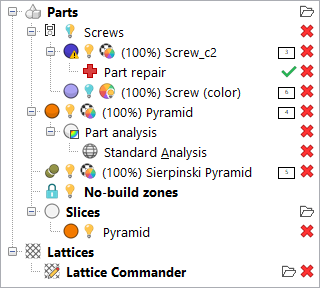A hierarchical display of a project's contents
What is it?
The project tree is a view in Netfabb. It lists all parts, slices, machine workspaces, other objects as well as loaded modules contained in a project, and it displays the relationship between these elements in tree-like fashion. For example, a module may be loaded on a part, and the loaded module is represented as a branch under the part.
What are its key features?
Sorting and organizing
- Top-level nodes hold elements of a project according to their type. The tree-like structure illustrates relationship between objects. Parts belonging to platforms, slices, latticing tools – all are sorted into their respective top-level nodes.
- Collapse and expand nodes to save display space
- Sort objects into groups for customized house-keeping in the tree. Groups can be nested in groups themselves.
- Use drag&drop to shuffle objects around
Accessing elements and functions
- Active modules loaded on individual parts are represented as sub-nodes, clicking those nodes accesses the respective instance.
Indicating element status and properties
- The project tree provides a number of details about the parts, slices, and structures in the model. This varies with the entry type. For example, for parts these include level of detail, visibility, display color, need of repair, shell count, part number. Slices have no shell count and cannot have their level of detail adjusted.

Example of parts, slices, and module branches loaded in the project tree.
